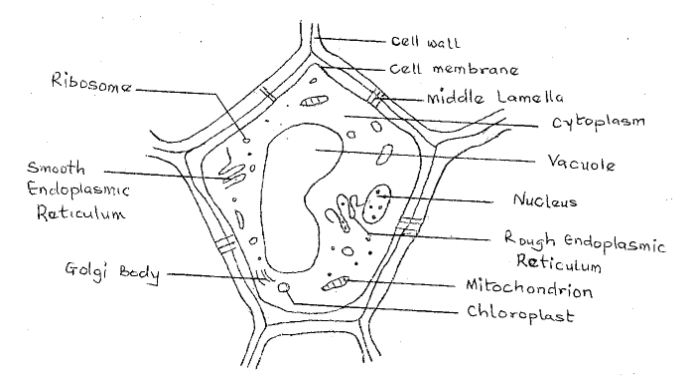Question 1
(a) (i) List three forms in which living cells exist. [3 marks]
(ii) Give one example each of the forms listed in 1(a)(i). [3 marks]
(b) Make a drawing, 6cm-10cm long, of a typical plant cell and label fully. [8 marks]
(c) (i) In a tabular form, state three differences between a plant cell and an
animal cell. [3 marks]
(ii) State three similarities between a plant cell and an animal cell. [3 marks]
Observation
Many candidates attempted this question and performed well.
Candidates were able to state the forms in which cells exist with their examples but lost
majority of the marks to spelling. Although some candidates wrote that cells exist in the soil, water, river instead of stating the forms in which cells exist.
Majority of the candidates could draw the shape of a typical plant cell but lost a lot of marks to inaccurate measurement, title, and other specifications. Some of the candidates drew an animal cell. Many candidates drew guidelines with free-hand and labelled vertically. The guidelines for labels used by some of the candidates were not touching the labels and were crossed.
Some candidates failed to tabulate the answer to 1(c)(i), hence lost one mark. Many candidates answered 1(c)(ii) satisfactorily.
The expected answers are:
(a) (i) Forms in which living cells exist
- Single/free-living;
- Colony/colonial;
- Filamentous/filament;
- Part of a living organism.
(ii) Example
- Single/free-living – Amoeba/Chlamydomonas/Paramecium/Euglena;
- Colony/colonial - Eudorina/Pandorina/Volvox/sponges;
- Filamentous/filament – Spirogyra/Chladophora/Ulothrix/Zygnema/Oedogonium;
- Part of a living organism – cheek cell/onion cell/epidermal cell/parenchyma cell.
Any correctly named example
NB- Spellings must be correct to score
(b) Diagram of a typical plant cell

Title (TL)
Quality (Q)
Size (Sz) (6cm-10cm)
Neatness of labels (NL) (Ruled guide lines x ½; Horizontal labels x ½)
Clarity of lines (CL) (Lines not broken x ½; lines not woolly x ½ )
Details (D)
Definite shape (DS)
Central large vacuole (CV)
Labels (L)
(Cellulose) cell wall, chloroplast, vacuole, middle lamella, cytoplasm, nucleus,
mitochondrion, (smooth/rough) endoplasmic reticulum, Golgi body, ribosome, cell
membrane.
NB- Spellings must be correct to score
(c) (i) Differences between a plant cell and an animal cell
Plant cell |
Animal cell |
|
lacks cellulose cell wall; |
- has one large central vacuole |
has numerous/small vacuoles; |
- has chloroplasts |
lacks chloroplast; |
- contains starch granules in its cytoplasm |
contains glycogen granules in its cytoplasm; |
- usually larger in size |
usually smaller in size; |
- does not have lysosome |
has lysosome; |
- does not have centrioles/ centrosome |
has centrioles/ centrosome |
- has a regular/ definite cell shape |
has an irregular/ indefinite cell shape. |
- cytoplasm less dense |
cytoplasm more dense |
|
stores lipid as fat |
NB: Points must correspond to score
No tabulation minus 1 mark NT – 1 mark
